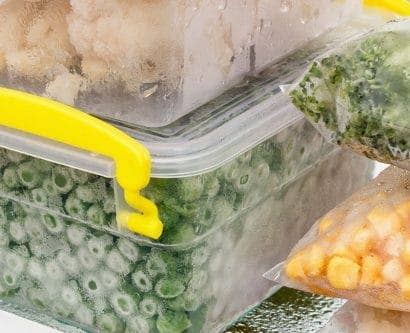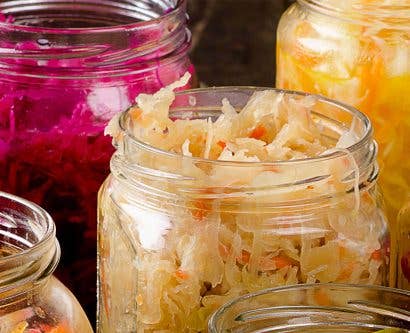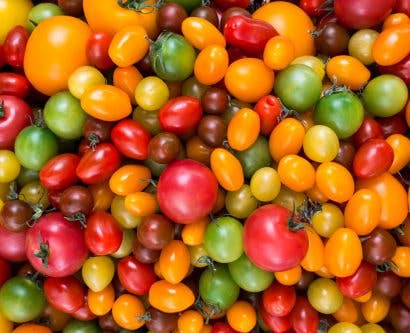How to Prepare Make-Ahead Meals
Sharing food with loved ones is a true joy. Food brings people together and this is never more true than when cooking for a crowd. However, as pleasant as this might initially sound, it can bring the stress of timing different courses, juggling cooking and hosting and trying not to burn your star dish.
This article will detail how to prepare, cook and store food for your guests as safely as possible. We will explain the different foods that you might want to consider making in advance, provide recipe ideas for inspiration, and most importantly discuss our top tips to ensure you feel confident in preparing your make-ahead meals safely.
Throughout the article, there are helpful tips in bold, these indicate specific food safety factors to consider for the corresponding preparation or cooking tip at the bottom of the article. Keep reading to learn about our top food safety tips.
What Food Can Be Made in Advance?
Many people choose to do a large portion of the food preparation and even cooking before guests arrive, and for good reason. However, you need to be aware of which foods can be safely prepared or cooked in advance without compromising the quality, flavour and texture.
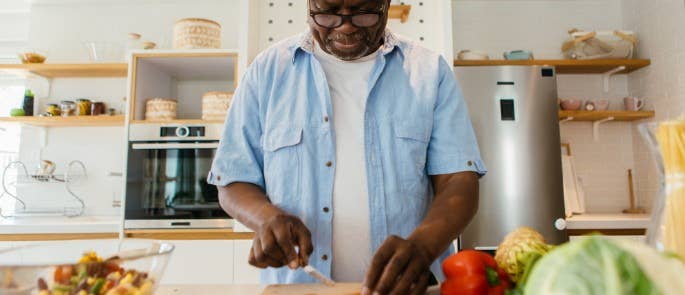
One option is to make your food ahead of time and freeze it until ready for use. Great examples of this include soups, stews, meat sauces and even some assembled recipes such as pies, lasagne or a fruit crumble. For more information on how to freeze food safely, take a look at our article.
Freezing is a great example of making food ahead of time. You can freeze certain ingredients to be used whenever needed or, as stated, you can even freeze completed recipes that will simply need reheating.
Take a look at this recipe for turkey & courgette meatballs in a roasted red pepper sauce. This is a great example of how freezing can cut down your time in the kitchen once guests have arrived.
For more recipes like this and information on the importance of nutrition and healthy eating in the diet, take a look at our Nutrition and Healthy Eating Course.
Another factor to consider when deciding what to make for a dinner party is making foods that can improve over time, for example, marinades, stews, sauces, curries or broths. You can make these a few days before and store them in the fridge until ready to use. Many of these dishes can be a little time-consuming to make, but you’ll get great-tasting food and a fraction of the effort when you come to safely reheating and serving it to your guests.
Marinating is another step you can take ahead of time and it can measurably improve the taste of the food you cook. Including salt in a marinade is one of the reasons this is such a useful step. Salting foods, such as cuts of meat before you cook them, will give you moist and juicy meat, which has been seasoned all the way through. For best results, season or marinate with salt, herbs and spices at least 2 hours before you intend to cook.
Looking to Learn More?
Food hygiene is essential in order to keep everyone who eats your food safe. We offer a wide range of courses, suitable for all levels. For more information on food hygiene and safety, including how to prepare food safely, take a look at our Food Hygiene Training.
Make-Ahead Meal Ideas for Entertaining
Below we have provided a few recipes to inspire you, or for you to use. Two of the recipes are vegetarian, with easy substitutes to make them vegan and one is a meat-focused dish. Considering your guest’s dietary requirements is an important part of hosting. Be sure to check if any of your guests are allergic to any of the ingredients you will use, if so you will need to take extra care around preventing allergenic contamination. To learn more about how to do this, read our article on the 14 named allergens, here.
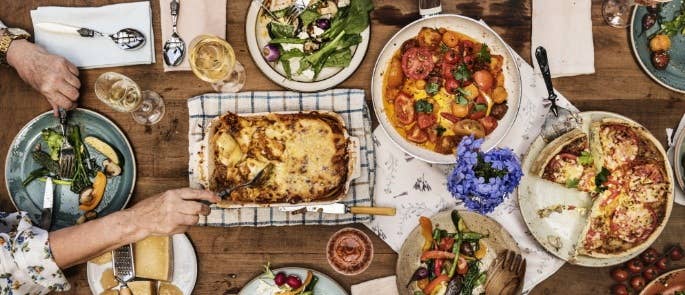
Leek and Potato Soup Recipe
Soup is an excellent choice for a starter at a dinner party. It can be made in advance and either stored in the fridge for 3 days or frozen and stored for up to 3 months. It’s recommended that you freeze your soup in a reusable, sealed silicone pouch or large sandwich bag. If you freeze a flat, thin layer of soup, it will defrost faster.
However, if you choose to cook a soup that contains pasta, it will not keep well in the fridge or freezer. This is because the pasta will end up soaking up too much liquid, leaving you with an overly thick soup and soggy pasta. To avoid this, freeze your soup without the pasta in. When you come to reheat a portion, you can cook smaller pasta shapes, like orzo, in your soup until it is al dente.
Chicken Marbella Recipe
Chicken Marbella is a dinner party classic and justifiably so when 90% of the hands-on cooking can be done long before your guests arrive. And it will even taste better the longer it marinates. Simply pop it in the oven to cook whilst you entertain your guests.
Slow-Cooked Aubergine and Tomato Sauce Recipe
For a vegetarian option, we have included a delicious pasta sauce recipe, which can be stored in the fridge for up to three days or frozen for 6 months until you need to use it.
We hope that you try out some of the above recipes when you next find yourself hosting. It is essential that you follow them safely. To be sure of this, pay attention to the safety tips provided in each recipe.
Food Safety Tips for Make-Ahead Food
As mentioned, it is essential that all food you prepare must be done in a safe and hygienic way. This is especially important when preparing food in advance, as there is more opportunity for things to go wrong. The rest of this article will look at the specific food safety factors you need to consider for each of the different stages of food prep mentioned above.

Reheating Food
Reheating food is a useful way to cut down on the time you spend cooking as your guests arrive. However, you need to make sure that you are reheating food safely. Reheating food incorrectly can allow harmful bacteria to multiply because the food is at a higher risk of entering the food danger zone. The Food Standards Agency (FSA) sets the danger zone between 8 °C and 60 °C and bacteria multiply rapidly between these temperatures. To find out more about the temperature danger zone, take a look at our article, here.
Furthermore, you need to make sure that the food you reheat reaches a core temperature of 70 °C for two minutes or 75 °C for 30 seconds. You can do this by using a probe thermometer. Take a look at our article on safely reheating food to the correct temperature to learn more.
In terms of food safety, as long as you reheat the food at the correct temperature and for the correct duration of time, it can be safely reheated. The Food Standards Agency (FSA) recommends that food is only reheated once, so follow this guidance wherever possible. For example, if you have a large batch of sauce, take out only what you need for that serving and reheat as needed.
When reheating food from frozen, you must make sure that the food has been thoroughly defrosted in the fridge before you do so. This ensures that you get an even temperature throughout the food and that you don’t get any frozen spots in the centre whilst the outside of the food is hot. For more information on the safe reheating of food, read our article, here. For guidance on what foods you can safely reheat, read our article, here.
Marinating Food
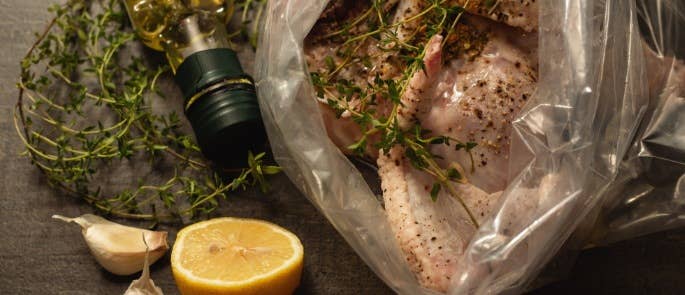
As mentioned, marinating food is a great way to impart lots of flavour into a dish and it can all be done long before people arrive. Firstly it is essential that you keep your fridge set to the correct temperature of between 1 °C and 5 °C. It should never be higher than 8 °C.
You should aim to marinate in the fridge if you are doing so for a prolonged period of time such as overnight. Furthermore, if you are marinating your food for a long period of time, you must make sure you cook the food before its use-by date.
However, if you only plan to marinate for 2 hours or less, you can leave the food outside of the fridge. In fact, many cuts of meat will cook better if they are first allowed to come up to room temperature. If marinating outside of the fridge, you must keep the food covered to avoid the risk of physical contamination.
If you are marinating raw meat in the fridge, then it is essential that you make space in your fridge and store it on the bottom shelf of the fridge to avoid any raw juices dropping down and contaminating other foods. You should have separate refrigeration areas for raw and ready-to-eat food. This is essential for preventing food from becoming contaminated with pathogenic organisms and this stands true when marinating your food.
Freezing Food
Making your food ahead of time and freezing it until ready for use is a massively helpful tool when cooking for a crowd. However, there are a number of factors to consider:
- Your freezer should be set to the correct temperature of -18 °C and -22 °C because bacteria cannot grow at these temperatures.
- You must not put warm food into the freezer as you risk increasing the temperature of the freezer thus, potentially creating an environment where bacteria could grow.
- You must make sure to defrost and reheat food safely. You must defrost slowly in a cold environment, such as a fridge. See above for how to safely reheat food from frozen.
- You should still separate raw and ready-to-eat foods, as you would in a fridge.
- You should label the food containers that you freeze so you know what they are and what date they were frozen on.
Washing Produce
Before you even begin cooking, there are some key safety factors to consider when handling fresh produce.
Ready-to-eat and raw foods, such as salad vegetables, fruits and pre-prepared vegetables, may be contaminated with soil, insects, pesticides, bacteria and viruses that could all cause illness, even if there are only a few present. To reduce these risks, it is essential to wash all fruit and vegetables thoroughly under clean running water before eating.
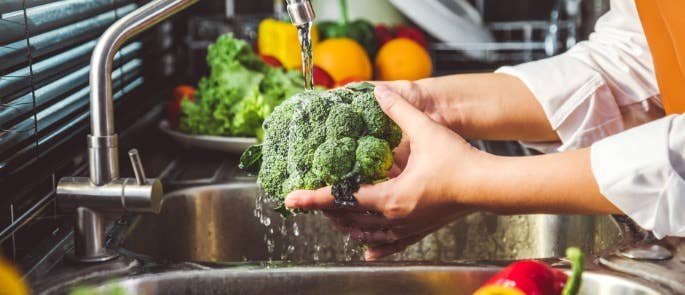
Use-By and Best Before Dates
Use-by dates are generally found on high-risk, perishable foods that require refrigeration. They state the date up to which the food is safe to eat. After the use-by date, food is unsafe and should not be consumed, cooked, or frozen. When preparing food in advance, it is important to be mindful of the use-by dates of the food you intend to cook. Make sure you do not serve any foods past their use-by date.
Best before dates indicate the length of time for which a food will be at its best quality. There is a little more leniency in using foods which have gone past their best before date. For example, using older, stale bread to make croutons is fine if it is past the best before date. In fact, making croutons from stale bread tends to work better than fresh bread. Although, you should still check for any signs of mould or contamination before using. Take a look at our article on the difference between use-by & best before dates.
We hope you enjoyed this article on the safe preparation, cooking and serving of make-ahead foods. We would love you to have a go at making some of the recipes featured in the article. If you do, be sure to post your recreations to your social media and tag us. Above all, it is essential to follow food hygiene rules when doing any preparation or cooking. Make sure to apply the food safety tips we have provided, to host your guests safely and confidently. For any more information, feel free to get in touch. High Speed Training offers a wide variety of courses and resources that can help.
Further Resources:
- How to Start a Meal Prep Business
- How to Start a Catering Business
- Safe Temperatures for Food Storage: A Free Guide to Cooling and Chilling Times
- A Healthy Eating Plan for Fussy Eaters
- How to Defrost Food Safely
- Online Food Hygiene Courses








